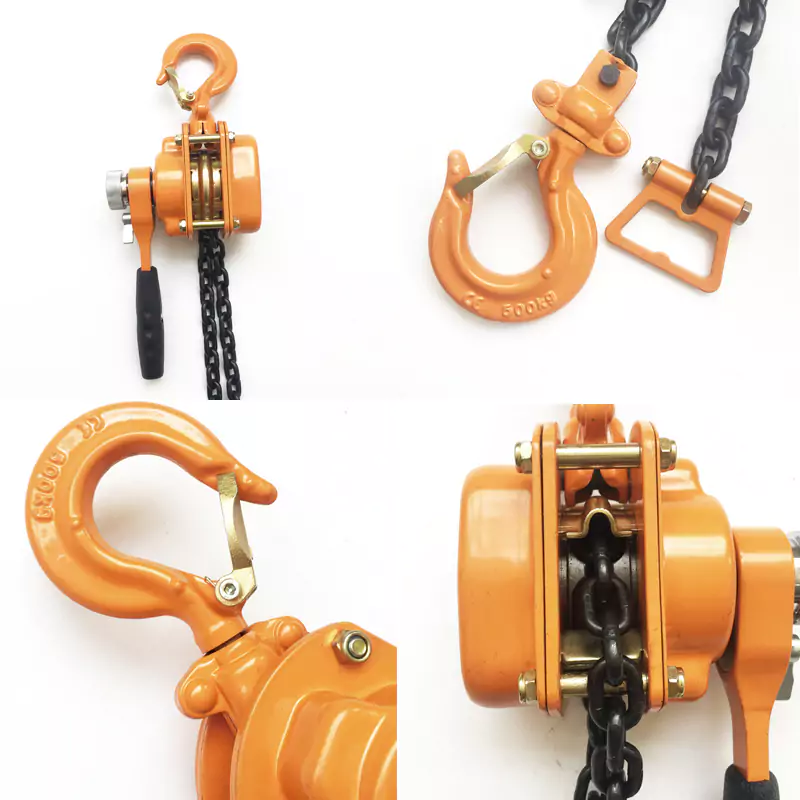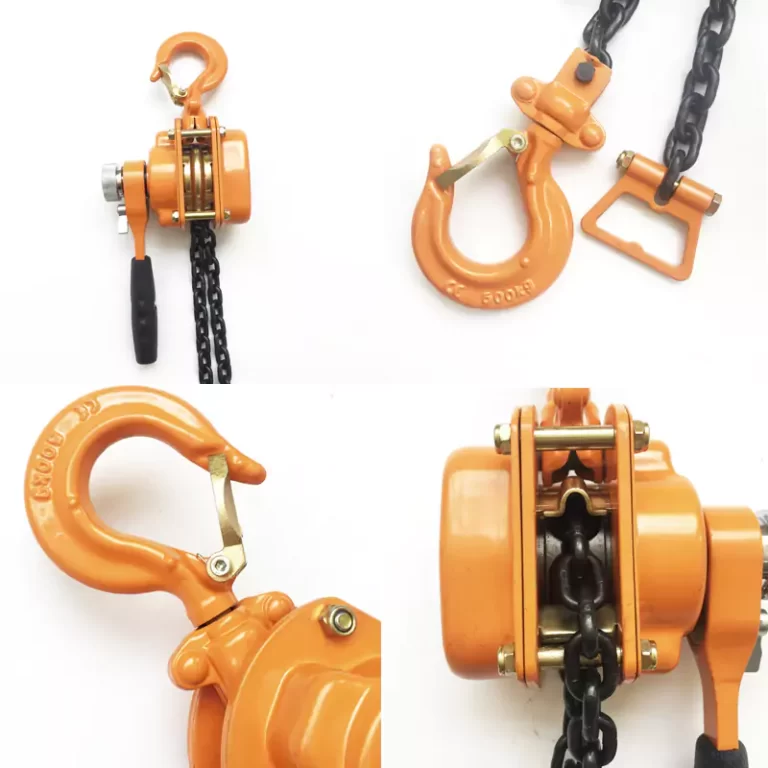1. Introduction
Lever hoists, also known as ratchet lever hoists or come-alongs, are compact manual lifting devices widely used in construction, manufacturing, shipbuilding, and maintenance operations. Their versatility lies in their ability to lift, pull, position, and secure loads in any direction. The key component that enables this functionality is the ratchet-and-pawl mechanism, a fundamental mechanical design that provides controlled, incremental motion and prevents reverse movement under load.
Understanding the engineering principles of the ratchet-and-pawl system is crucial for appreciating how lever hoists achieve their combination of precision, mechanical advantage, and safety. This essay explores the working principles, design considerations, mechanical efficiency, and safety implications of this mechanism, offering a detailed look into how it governs load control and operator security.
2. Overview of Lever Hoist Design
A lever hoist consists of several integrated components: a hand lever, gear train, ratchet wheel, pawl, load chain, lifting hook, and friction clutch or brake system. Unlike a chain block, which uses a hand chain to rotate a gear continuously, a lever hoist converts the oscillating motion of a lever handle into incremental rotation of a load gear via the ratchet-and-pawl system.
This mechanism allows the user to lift or lower loads by simply moving the handle back and forth, which makes it suitable for tight or awkward spaces where continuous hand-chain rotation is impractical.
At the core of the system, the ratchet wheel and pawl act as mechanical locks that permit motion in one direction while preventing backsliding in the opposite direction. This “stepwise control” enables precise load positioning and ensures the load remains secure at any point during lifting or suspension.
3. Engineering Principle of the Ratchet-and-Pawl Mechanism
3.1 Basic Mechanics
A ratchet wheel is a circular gear with asymmetrical teeth—each tooth has a steep side and a sloped side. The pawl is a lever-like component that engages the teeth. When the wheel rotates in the allowed direction, the pawl slides smoothly over the sloped side of the teeth. When reverse rotation is attempted, the pawl catches against the steep side, locking the wheel in place.
This interaction creates a unidirectional motion—a fundamental property used in lever hoists for both holding loads and achieving controlled incremental lifting.
3.2 Mechanical Advantage
The ratchet-and-pawl mechanism doesn’t create mechanical advantage directly—it acts as a motion converter and holding device. The actual lifting force is achieved through the gear train, which amplifies the user’s input torque from the lever. The ratchet simply ensures that the load does not back-drive the system when the lever is at rest or during repositioning strokes.
In engineering terms, the ratchet-and-pawl system functions as a non-reversible mechanical linkage. It ensures that torque is transmitted in one direction only, allowing energy input from the operator to be stored as potential energy in the lifted load, without any loss from reverse motion.
4. Components and Design Considerations
4.1 Ratchet Wheel Geometry
The tooth profile of the ratchet wheel is designed with asymmetry to balance smooth operation and positive locking. The pressure angle, tooth depth, and backlash clearance must be optimized:
-
A shallow slope on the drive side minimizes friction and wear during forward motion.
-
A steep locking face ensures that reverse loads press the pawl tightly against the tooth, increasing locking reliability.
-
Excessive clearance between teeth and pawl can cause “backlash,” leading to shock loads or slippage.
High-strength steel alloys or heat-treated carbon steels are typically used to resist deformation under repeated cyclic loading.
4.2 Pawl Design
The pawl is usually spring-loaded to maintain constant engagement with the ratchet wheel. It is designed to pivot around a pin and must provide:
-
Sufficient contact area to distribute load stresses evenly.
-
Wear resistance to prevent tip deformation.
-
Low friction for smooth disengagement during operation.
In advanced lever hoists, dual pawl systems are employed to increase safety redundancy—if one pawl fails, the other maintains the lock.
4.3 Spring Mechanism
The return spring ensures that the pawl engages automatically after each lever stroke. The spring’s stiffness must be calibrated: too weak, and the pawl might skip; too strong, and frictional losses increase. Proper spring design ensures consistent operation even under vibration or environmental contaminants.
5. Functional Phases of Operation
The ratchet-and-pawl mechanism operates through three distinct functional phases:
5.1 Lifting Phase
When the operator pushes or pulls the lever, the motion drives the ratchet wheel in the lifting direction. The pawl slides over the sloped faces of the teeth, creating a series of controlled, incremental advances. Each stroke lifts the load slightly higher, with the pawl locking the wheel at the end of every increment.
5.2 Holding Phase
When the lever is at rest, the pawl engages firmly with the teeth, preventing backward rotation. The entire load is held by the engagement between the pawl and the ratchet wheel, supported by the brake system and gear train.
5.3 Lowering Phase
When the user shifts the selector to the “lower” position, the pawl’s engagement direction is reversed. Controlled release of the load occurs through incremental back-rotation, with the brake system ensuring smooth deceleration.
6. Influence on Load Control
The ratchet-and-pawl mechanism provides exceptional control over load motion due to its incremental nature:
-
Precision Positioning: Each lever stroke moves the load by a small, predictable increment. Operators can align machinery, beams, or structures with millimeter-level precision.
-
Load Stability: Because the pawl locks after each stroke, the load cannot drift or fall between movements.
-
Bidirectional Capability: The reversible ratchet mechanism allows both lifting and lowering without changing setup.
-
Immediate Braking: The ratchet instantly engages upon lever release, acting as an automatic brake.
In industrial terms, this results in fine load modulation—the operator can “feel” the resistance through the lever and apply appropriate force, enhancing tactile feedback and reducing the likelihood of overload.
7. Influence on Safety
Safety is perhaps the most critical aspect influenced by the ratchet-and-pawl system. Several key mechanisms contribute to the overall protection of both the operator and the load.
7.1 Prevention of Backsliding
The fundamental safety function is to prevent any reverse motion. Once a load is lifted, the pawl prevents the ratchet wheel—and consequently the load chain—from moving backward, effectively locking the load in place even if the operator releases the lever.
7.2 Redundancy and Fail-Safe Design
Many high-quality lever hoists use dual-pawl systems, where two independent pawls engage the ratchet wheel simultaneously. This redundancy ensures that even if one pawl fails or is damaged, the other continues to secure the load, meeting safety standards such as ASME B30.21 or EN 13157.
7.3 Integration with Friction Brake
The ratchet mechanism often works in conjunction with a mechanical friction brake or load brake system. When lifting stops, the brake automatically engages under load torque, ensuring static holding even if the pawl disengages during maintenance or malfunction.
7.4 Overload Protection
Some modern lever hoists incorporate overload limiters that slip the ratchet or disengage the gear when excessive torque is applied. This prevents structural or mechanical damage and protects the user from excessive manual strain.
7.5 Inspection and Wear Detection
Because the ratchet and pawl undergo frequent engagement cycles, their wear patterns are visible and predictable. Regular visual inspections can easily identify rounded teeth, bent pawls, or spring fatigue, enabling preventive maintenance before failure occurs.
8. Engineering Challenges and Optimization
8.1 Friction and Wear
Each engagement generates localized contact stress and frictional heat. To minimize wear:
-
Surface hardening (carburizing or nitriding) increases resistance to abrasion.
-
Lubrication reduces friction, though excessive grease may attract dust and debris.
-
Material pairing (steel on bronze, for instance) can reduce galling and improve longevity.
8.2 Noise and Vibration
The repetitive clicking of pawl engagement can generate noise and vibration. Engineers mitigate this by optimizing tooth pitch and adding damping materials. In precision environments, silent ratchet mechanisms are used, with elastomeric or magnetic pawl return systems.
8.3 Load Capacity Scaling
Scaling the ratchet-and-pawl system for high-capacity hoists introduces stress concentration issues. Tooth geometry and pawl thickness must be proportionally increased to maintain the same safety factor. Finite element analysis (FEA) is often used to model these stresses under dynamic load conditions.
8.4 Environmental Factors
Corrosion, dust, and freezing temperatures can hinder pawl engagement. Sealed ratchet housings, stainless components, and synthetic lubricants are used in marine or offshore applications to maintain reliability under harsh conditions.
9. Case Studies in Safety and Performance
Practical experience from industrial applications highlights the criticality of ratchet-and-pawl reliability:
-
In shipbuilding, lever hoists are used for rigging and pipe alignment. The locking reliability of the ratchet prevents sudden load drops even when external forces (like wave motion) act on the suspended load.
-
In construction, ratchet hoists enable safe horizontal pulling of heavy beams. The ratchet ensures each step of movement is stable, reducing risk of uncontrolled motion.
-
In utilities maintenance, linemen rely on lightweight lever hoists for cable tensioning; precise incremental control is essential for avoiding line snapback injuries.
In all these examples, the safety and control advantages stem directly from the ratchet-and-pawl’s unidirectional locking principle.
10. Emerging Innovations
Modern lever hoist design is evolving with improved ratchet technologies:
-
Self-adjusting pawls that maintain optimal engagement under varying wear conditions.
-
Composite materials for lightweight pawls that reduce inertia and noise.
-
Sealed ratchet housings to eliminate contamination and reduce maintenance.
-
Integrated sensors to measure torque and detect incomplete engagement, sending alerts to operators in smart industrial environments.
These innovations are transforming the traditional mechanical ratchet into a hybrid electromechanical safety device, aligning with Industry 4.0 trends.
11. Conclusion
The ratchet-and-pawl mechanism embodies simplicity and reliability—qualities that make lever hoists indispensable in manual lifting and pulling operations. Its fundamental engineering principle—allowing motion in one direction while preventing reverse movement—creates both precise load control and intrinsic safety.
By converting intermittent manual input into controlled incremental motion, the system provides tactile precision, mechanical security, and immediate braking capability. When integrated with robust materials, friction brakes, and overload protection systems, it forms a comprehensive safety architecture capable of handling a wide range of industrial challenges.
In essence, the ratchet-and-pawl mechanism is not merely a mechanical component—it is the heart of the lever hoist, embodying the balance between human effort, mechanical advantage, and safety assurance. Its thoughtful engineering ensures that even the most compact manual hoist can lift with strength, control with precision, and hold with absolute confidence.


